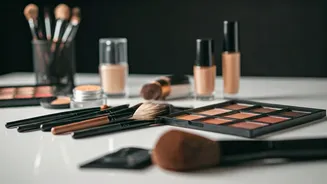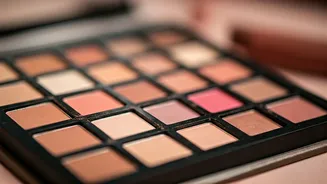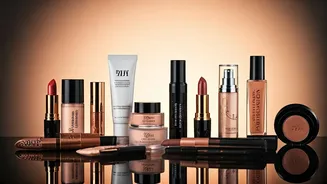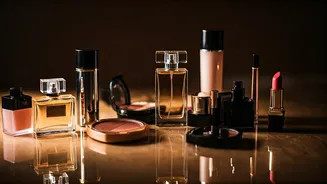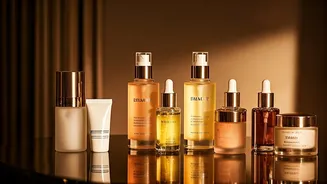Makeup Basics Unveiled
Getting started with makeup begins with understanding the basics. A solid skincare routine is the foundation. Cleansing, moisturizing, and applying sunscreen
are crucial for prepping your skin. Next, choose the right tools: brushes, sponges, and applicators that suit different products. Foundation, concealer, and setting powder create a flawless base. Foundations come in various forms (liquid, cream, powder), catering to all skin types. Concealers hide imperfections, and setting powders lock everything in place. Mastering these foundational elements is the first step towards creating any makeup look.
Face Makeup Essentials
Face makeup involves more than just foundation and concealer. Contouring and highlighting use shadows and light to sculpt features. Bronzer adds warmth and dimension. Blush gives a healthy glow. Choosing the correct shades is crucial; match your skin tone and desired look. Using the right brushes matters. Contour brushes are for precision, while blush brushes provide a soft application. Experimenting with different products and techniques helps you identify what works best for your unique features and style. The goal is to enhance your natural beauty, not completely change your appearance.
Eye Makeup Demystified
Eyes are the windows to the soul, and eye makeup lets you enhance them. Eyeshadows offer endless possibilities, from subtle daytime looks to dramatic evening styles. Eyeliners define the eyes; choose from liquid, gel, or pencil based on your skill and desired effect. Mascara adds volume and length to lashes. Start with eyeshadow, then eyeliner, and finally, mascara. Blending is key to a smooth finish. Different eye shapes benefit from different techniques: hooded eyes require specific placement of eyeshadow, while round eyes can handle bolder looks. Practice is essential to master the art of eye makeup.
Lip Makeup Techniques
Lip makeup can complete any look. Lipsticks, lip glosses, and lip liners each have unique uses. Lip liners define the lip shape and prevent lipstick from feathering. Lipsticks offer various finishes, from matte to glossy. Lip gloss adds shine and fullness. Begin with lip liner, then apply lipstick or gloss. Selecting the correct lip shade depends on your skin tone and the overall makeup look. Experimenting with colors and finishes helps you find what complements your features and style best. Proper lip care is essential; keeping lips hydrated ensures smooth application.
Makeup for Different Occasions
Makeup styles differ based on the occasion. A natural, everyday look involves light foundation, mascara, and a touch of blush. For work, opt for a polished, professional appearance. Evening looks can be more dramatic, incorporating smokey eyes, bold lips, and contouring. Special events, like weddings or parties, call for more elaborate techniques. The key is to adjust your makeup to suit the environment and your personal style. Practice different looks beforehand, especially for important events, to ensure you feel confident and comfortable with the result.
Makeup Tools and Hygiene
The right tools are essential for effective makeup application. Brushes come in various shapes and sizes, each designed for specific tasks. Sponges offer a different texture and finish. Maintain hygiene by cleaning your brushes regularly with brush cleaner or mild soap. Replace sponges frequently. Cleanliness prevents bacteria buildup and prolongs the life of your makeup products. Proper tool care ensures that your makeup applies smoothly and lasts longer, protecting your skin from breakouts and irritations.
Skincare's Role Explained
Skincare is the foundation for good makeup application and overall skin health. A well-established skincare routine prepares the skin for makeup. Cleanse, exfoliate, and moisturize daily, tailored to your skin type. Sunscreen is essential for protecting your skin from sun damage. Proper skincare minimizes imperfections, creating a flawless base for makeup. Regular skincare helps makeup apply more smoothly and last longer. Addressing skin issues like dryness or oiliness before applying makeup ensures better results.
Product Selection Guidance
Choosing the right makeup products can be overwhelming, so consider these factors. Skin type (oily, dry, combination) determines which formulations work best. Research reviews and recommendations. Try samples before buying full-sized products to ensure compatibility. Consider your budget, prioritizing quality over quantity. Building a collection takes time. Start with the essentials and gradually add products as you experiment. Choosing the right colors based on your skin tone and undertones is also critical for a cohesive look.
Common Makeup Mistakes
Avoiding common makeup mistakes improves your application technique and results. Using the wrong foundation shade creates an unnatural look. Overloading your face with product looks cakey. Not blending properly leaves harsh lines. Neglecting eyebrows can throw off the balance of your face. Overdoing contour or blush can be unflattering. Rushing the process leads to mistakes. Take your time, practice often, and seek advice from makeup tutorials and professionals. These are key to achieving a polished and professional look.
Makeup Trend Forecast
The beauty world consistently evolves. Keep an eye on current trends. Natural, 'no-makeup' makeup continues to gain popularity. Bold, vibrant colors and graphic eyeliner are also in style. Skin is trending towards a dewy, radiant finish. Experiment with innovative textures and techniques to stay current. Social media and beauty influencers offer constant inspiration. Embrace what feels right for you, while staying open to new ideas and techniques. Makeup is a form of self-expression; enjoy the process of exploring and refining your style.
